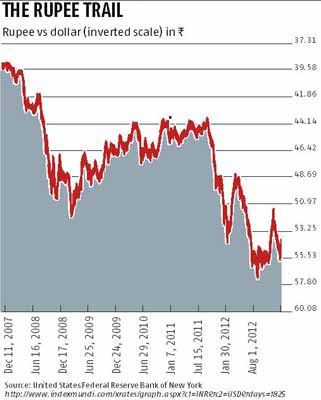Our inflation is driven by increasing fuel and high-technology imports, with rising oil and coal prices and structural constraints on capacity and productivity -- aside from expanding demand as purchasing power increases, writes Shyam Ponappa It's ironic that when our economy finally developed a head of steam after many false starts, the sky fell in, as crony deals like the spectrum and land allocation scandals unravelled.
It's ironic that when our economy finally developed a head of steam after many false starts, the sky fell in, as crony deals like the spectrum and land allocation scandals unravelled.
A sizeable transformation of upwardly mobile consumption powered the transition from a laggard to global front runner, despite misgovernance.
Now, the legacy of poor infrastructure, scams and an 'Indian spring' -- with many valid anti-corruption demands but impractical solutions threatens to derail stability, severely damping productive activity.
This jeopardises the very basis of our economic momentum: a burgeoning market.
Assorted blunders add to the chaos, eg, judicial rulings that contravene the sanctity of contracts, and misguided institutional action, like the Reserve Bank of India trying to force the government towards fiscal responsibility instead of concentrating on providing stability and support for growth.
This is aggravated by a government that does not seem to act in the public interest, and a frustrated Opposition that stalls governance and parliamentary proceedings.
The result is a marked inability, or unwillingness, or both, to act rationally and comprehensively on forward-looking, achievement-oriented plans -- except to tide over crises, stay in power somehow, and capture the treasury for opportunistic ends.
The empowered group of minister's decision last week to merely reduce the 1800 MHz spectrum reserve price by 30 per cent where there were no bids is a good example.
To see why, compare the end results that would best serve our common interests with the consequences of the government's approach and actions.
What is the effect on inflation of butterfly wings or a hurricane in telecom?
To decipher this, consider the drivers of inflation in India, and how such decisions affect them.
Supply constraints need structural changes in capacity and productivity:
Our inflation is driven by increasing fuel and high-technology imports, with rising oil and coal prices and structural constraints on capacity and productivity -- aside from expanding demand as purchasing power increases.
(There's also the import of gold, of course, possibly fuelled by lacklustre financial alternatives.)
This shows up in a steadily depreciating rupee after August 2011, falling 25 percent from Rs 44 per dollar to Rs 55 (see chart).
Some economists and foreign exchange advisors consider this as salutary, because India's goods and services become more competitively priced.
A weak currency can be advantageous up to a point, but only if it is exploited through competitive product and service offerings to yield sustainable profit margins.
If, however, there is no complementary rise in capacity and productivity to capitalise on market access through the weak rupee, we end as we are today -- where the disadvantages of essential imports with a weak currency outweigh the benefits of thin margins in low-productivity labour arbitrage.
Likewise, structural supply constraints remain intractable in the absence of increases in production.
Increasing supply involves improving entire process chains:
In other words, deep and sweeping changes in areas where we have not achieved such so far.
The requirements for productivity improvement, likewise, are improved infrastructure such as communications services, power supply, storage and delivery including logistics and transportation -- again, areas of weakness and inability to deliver that are mired in a policy stalemate, such as in power supply and telecom.
In short, inflation is likely to continue unless supply increases through improvements in production capacity and productivity.
Therefore, waiting for inflation to fall before cutting interest rates to stimulate growth is futile.
While rate cuts alone are inadequate, as there need to be structural solutions in parallel to build capacity and productivity, it is equally true that without integrated, synchronised initiatives in all these aspects, supply constraints will drive inflation.
Over the last two years, the RBI has shown the inefficacy of raising interest rates to combat inflation.
It has only succeeded in slowing growth to a painful rate of under 5.5 per cent, contributing to our social pressures and turmoil.
Instead of playing chicken and trying to stare each other down, the government and the RBI need to address growth in tandem, the former by eschewing fiscal irresponsibility and taking bold steps in the public interest, the latter by cutting rates, while introducing real-time systems for selective credit management to minimise misallocation and asset bubbles.
Decisions on spectrum as an example of structural reforms:
The EGoM's decisions on spectrum policy have major implications for productivity and user services for everyone, apart from the operators. Communications services are a basic enabler for effectiveness and efficiency.
Increases in supply are facilitated once the infrastructure is in place. For this, we need supportive policies and incentives.
Our spectrum allocation approach does not serve these purposes, because the growth in the sector has been largely of voice services and the delivery has been skewed in favour of remunerative urban areas while rural areas have insufficient coverage.
This is partly the consequence of allocating narrow bands of spectrum that suffice for voice services but are inadequate for data delivery, and partly because of costs.
Auctions are inappropriate for developing economies like India because (a) they add to infrastructure costs in place of investment in service delivery; and (b) they lead to the fragmentation of spectrum for exclusive use that is contrary to what's needed for data delivery.
Our operators have an average spectrum holding of about 10 MHz, whereas they need at least 2x20 MHz.
Our policy makers seem unaware that new technologies for broadband need much more spectrum.
Advanced data services are not possible otherwise, and rural users in nearly two-thirds of India will continue to be deprived of high-speed data access.
A radical change in approach by sharing available spectrum will make broadband access much more feasible as well as cost-effective.
This is the way to build productivity gains and distributed capacity for supply.
The EGoM's decision has to unleash this sector, instead of merely loosening a revenue-focused stranglehold.











 © 2025
© 2025